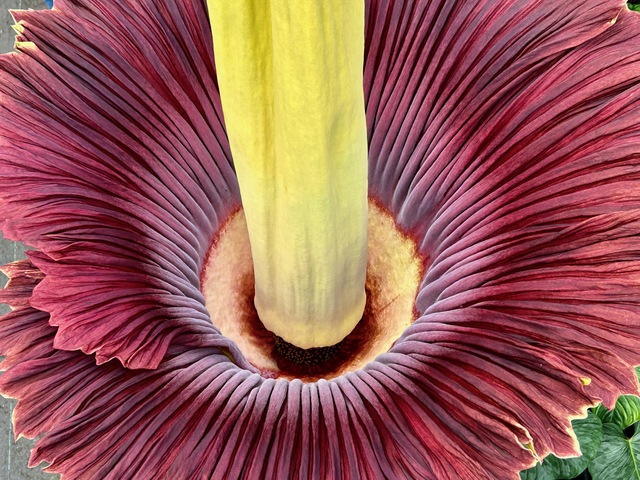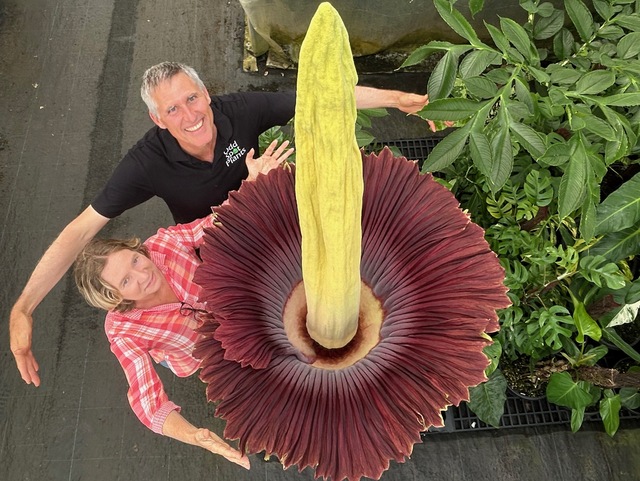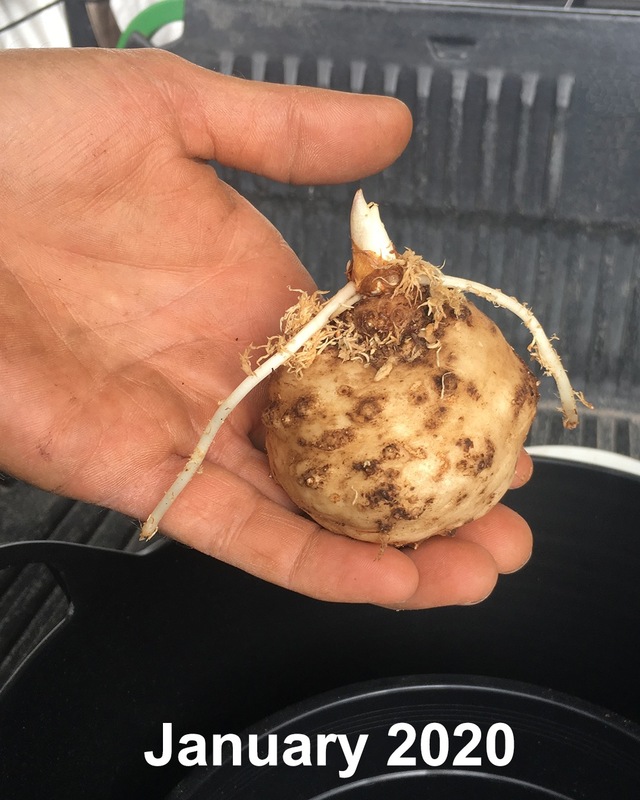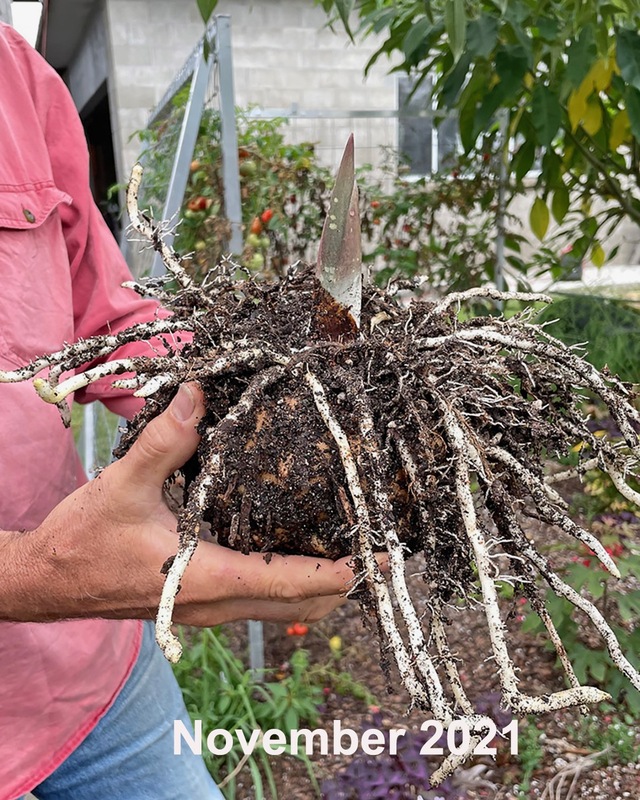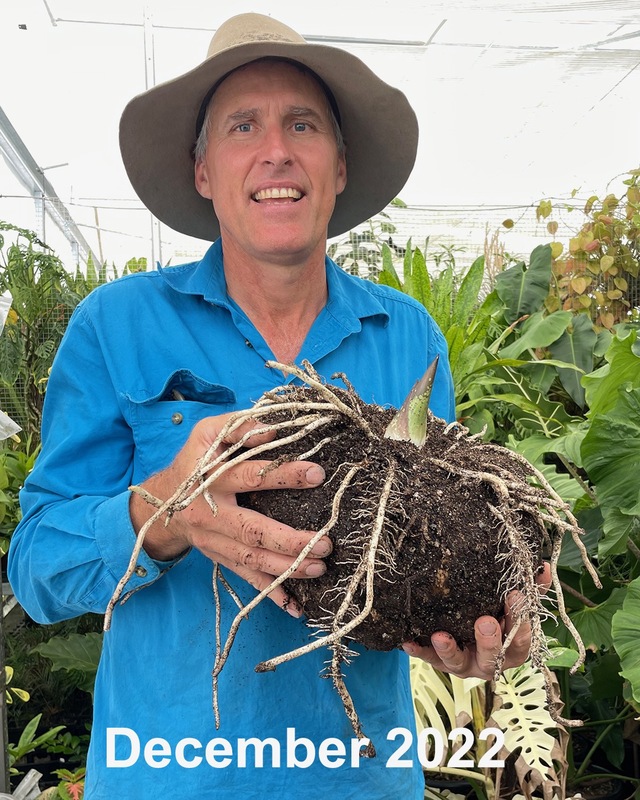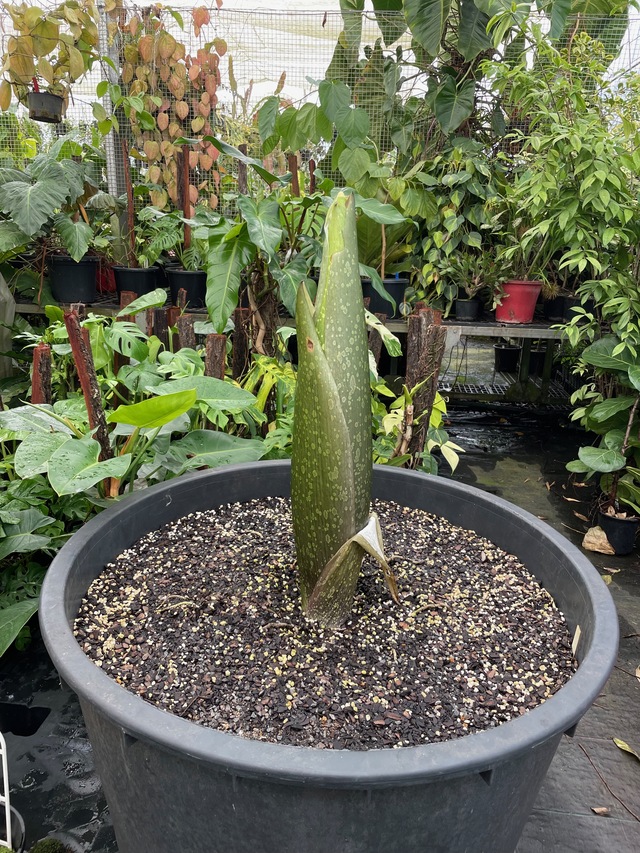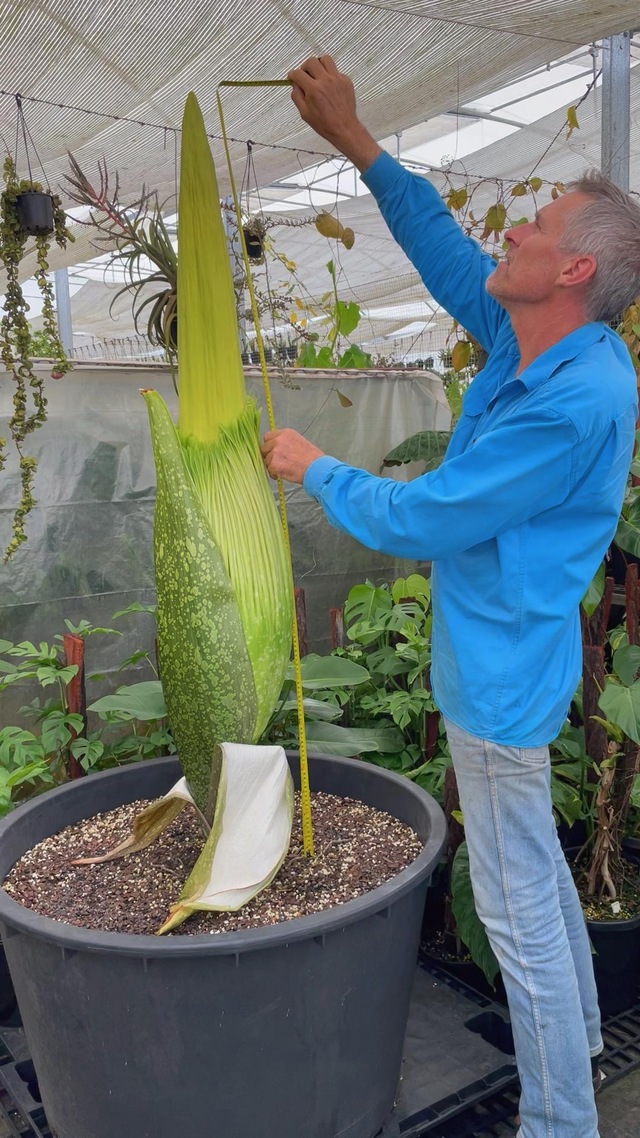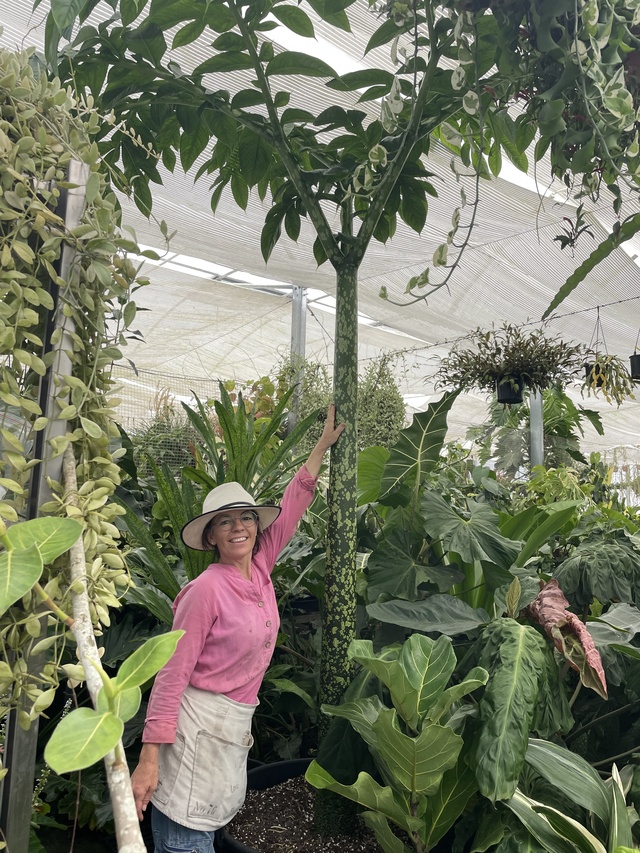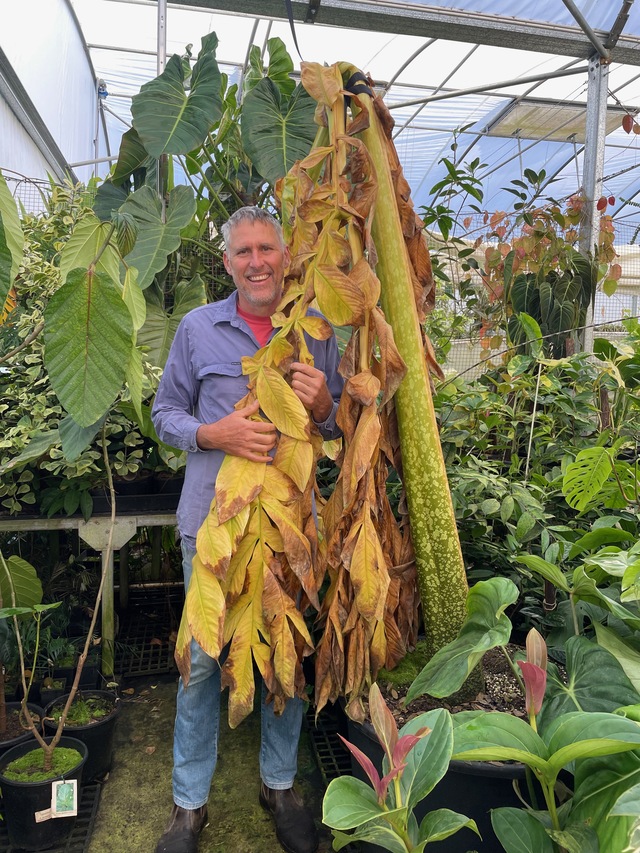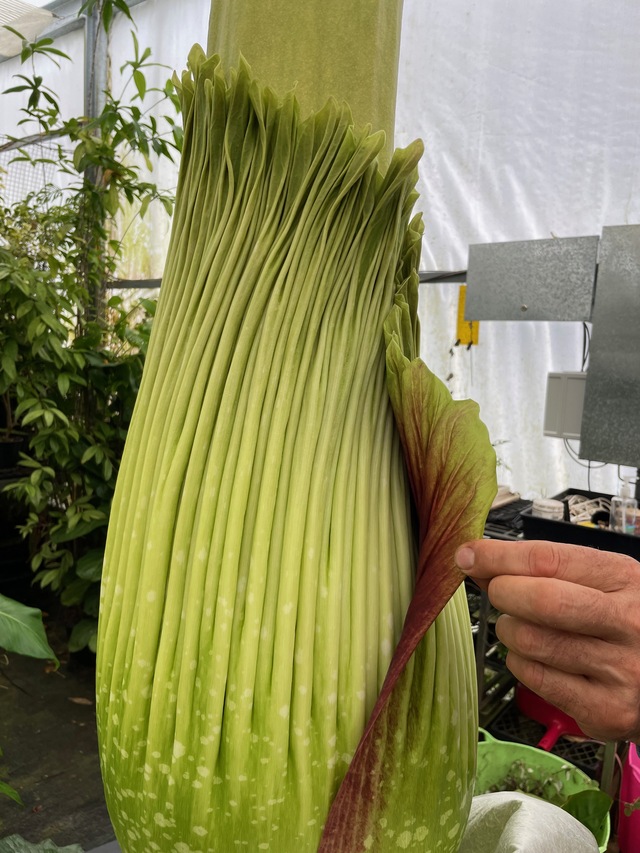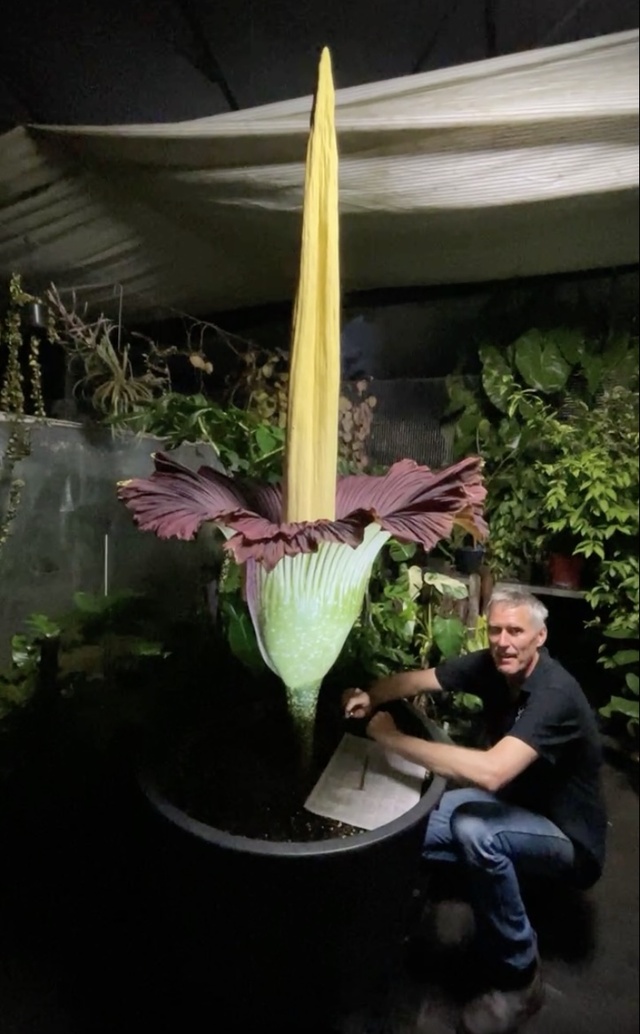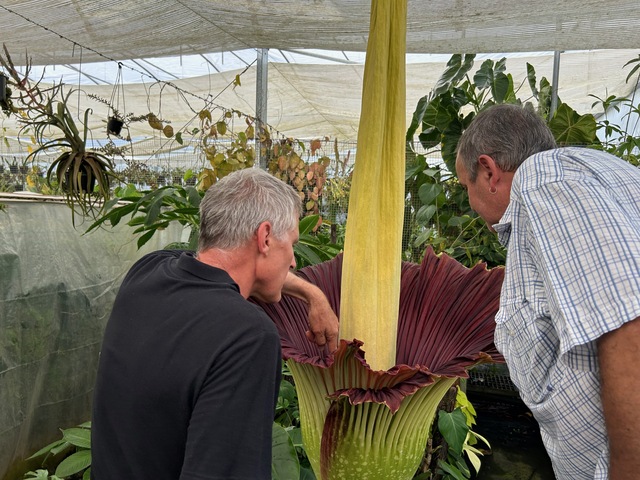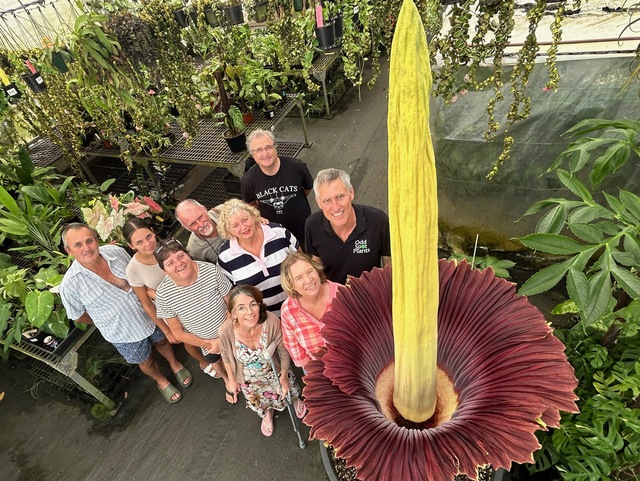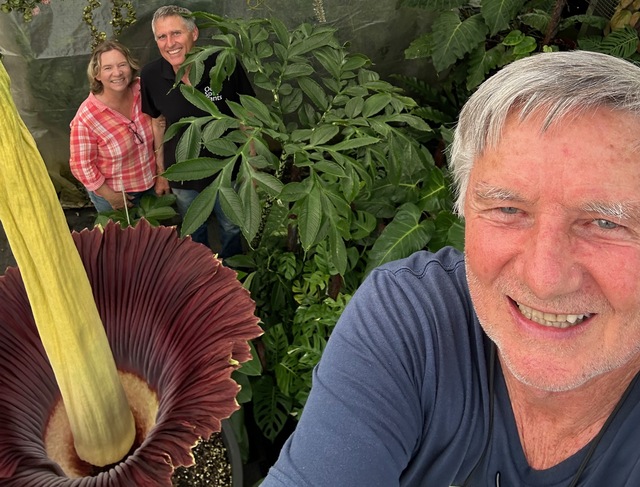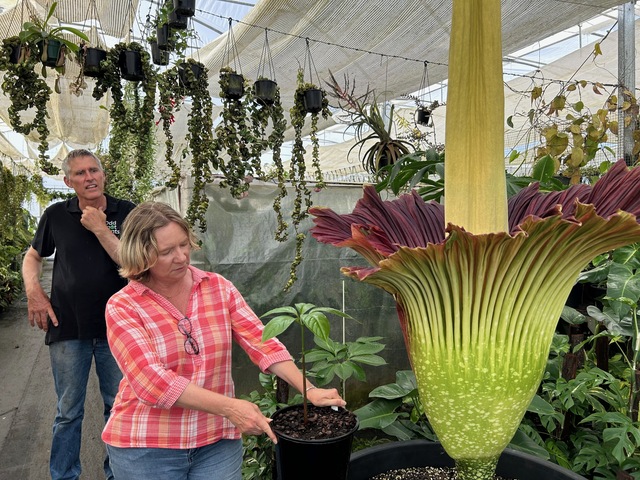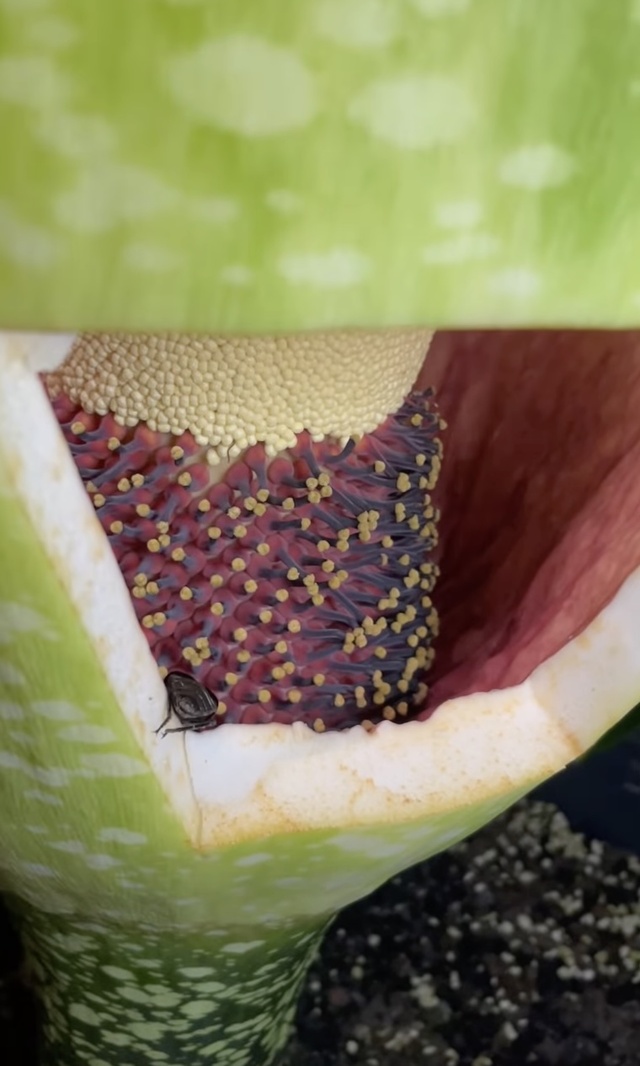Rare, unusual and quirky plants are what Neil and Lisa Paterson specialise in at their nursery in Goomboorian.
For the past eight years the couple have been growing hundreds upon hundreds of different plant species.
Now their passion is rewarding the effort and patience they have put in at Odd Spot Plants with the long-anticipated flowering of Amorphophallus Titanum.
Known also as the Titan Arum and more commonly referred to as the Corpse Flower, it has the largest unbranched inflorescence (flower) in the world.
It is endemic to rainforests on the Indonesian island of Sumatra, and it is reported there are less than 1000 left.
Flowering is not something that happens every year. The Titan Arum flowers for one night and it can take anything between five and 10 to 12 years before it does that.
It gets the name Corpse Flower because when the flower opens, it gives off the smell of rotting flesh. This is to attract insects – carrion beetles – that will hopefully spread pollen and create seeds for nature’s lifecycle to continue.
“That’s why it’s a bright red colour,” Lisa said. “To attract the beetles.”
Neil and Lisa contacted me early this month with their exciting news. It brought back memories of waiting for the birth of a baby.
It was exciting, there was expectation and a nervous wait.
How much has it grown? Is the leaf starting to open? Can you see the colour of the flower yet? When do you think it will fully open? These are the sort of questions they are asked.
Neil and Lisa planted an onion-sized bulb in January 2020 and nurtured the specimen year on year as the single leaf dies back. At first this was after nine months but then it became progressively longer in between.
They re-pot it and then wait to see if this year will be the one – the one when the leaf is a flower.
The Corpse Flower was in the news recently with one at the Cairns Botanic Gardens and earlier last year at Geelong.
“They are rare in botanic gardens,” Lisa said, “and even more rare for individuals like ourselves to have one burst into flower.”
In December 2022 the bulb weighed 16kg and the leaf died back in July 2024 – after 18 months.
Then in November 2024 the bulb was 38.7kg and the flower emerged in December. By January 1 the flower spike was already 1.5m and still growing.
Naturally Neil was measuring it’s growth day by day.
“What day it will actually ‘flower’ is anyone’s guess at this stage,” Lisa said on New Years Day, “… but it is looking pretty spectacular.”
By the Thursday the colour of the flower was starting to reveal itself, and Saturday night was being mentioned as a possible time for it to burst upon the scene.
Phone me at any time, day or night, when you expect it to flower, I told them, and joined in the waiting game.
“You will be in for an experience,” Lisa said.
Odd Spot Plants Nursery specialises in all of those hard-to-find plants, and pride themselves on professionally grown, healthy species.
While most nurseries concentrate on hundreds of plants of a similar species, Neil and Lisa specialise in many, many different species.
At their small operation, they specialise in indoor foliage and variegated plants you just can’t find at your local nursery.
There are a series of sheds and greenhouses or ‘tunnels’ that Neil and Lisa have built on the 80-acre property.
They both love the rare, unusual and quirky nature of the botanical world.
Neil’s obsession with all things green ensures he keeps finding all sorts of ‘plant treasures’.
“The only thing you won’t find us growing is anything with prickles,”Lisa said – I’ve drawn a firm line there.
“We can grow anything as long as there are ‘no’ spikey things.”
Born at Bundaberg, Lisa’s family were intensive farmers at Kelke, near The Hummock.
While attending university at Gatton she met Neil, both having a strong interest in agriculture and horticulture.
Neil was born and bred in Gympie and it was after uni that he and Lisa travelled – first for work and then around Australia.
Both of his parents were plant mad. His father Bill Paterson was a teacher at Gympie High School for 35 years.
On top of that, he was an orchid judge for years and set up the Tropical Orchid Council on the Sunshine Coast.
Neil’s mother, Margaret, was awarded an Order of Australia Medal for her contribution to horticulture for growing bromeliads.
Margaret was hybridising tillandsias – commonly known as air plants – in the 1960s and ’70s.
Deciding to make a career out of his passion, Neil studied a four-year Degree in Horticulture at the University of Queensland and has had a hands-on involvement in horticulture ever since.
A total plantsman, he enjoys the breeding and more intricate components of the industry.
They propagate and grow all their own own plants by traditional methods – there is no tissue culture.
They don’t go for buy-in plants and present them for resale once they are established, instead choosing to grow from cuttings or seed.
The nursery is not open to the public, instead relying upon on-line sales or in-person service at Plant Presents in Gympie.
The Corpse Flower is one of the more unusual plants they have growing. It builds up energy from the leaf and stores it in the bulb that grows underground.
There is no trunk, it’s just the stem that protrudes and the bulb generally has to grow to somewhere between 50kg and 120kg before it flowers.
Plants such as this have a special flower and in the wild – wherever they come from – one insect will pollinate one species of plant.
So if that insect is wiped out, eventually the plant will be too.
“The flowers are often only receptive between 10pm and midnight,” Lisa said. “Sometimes you have a 20-minute window to pollinate them, either flower to flower or freezer to flower … it’s a real labour of love.”
To this end they were fortunate to have a colleague in Brisbane who had frozen some pollen, so they planned to use that to bring on new seeds.
By the Saturday morning, 4 January, the inside of the flower was already a crimson colour.
The skirt of the flower – spathe – will then fold out to reveal the spike – spadix, Lisa said.
“It’s looking more like Sunday night or Monday. When it slows to about 10mm in growth, then it is time.”
Being part of the araceae family, that includes philodendrons and monsterios, it has male and female flowers on the spadix.
There are hundreds of little individual flowers, and the whole lot makes up the inflorescence – main flower.
Underneath, are the female flowers, and above that the male flowers.
On the spadix the female flowers are at the bottom, the male flowers are next and the scent area is at the top.
“What we can see at the moment is the scent glands,” Lisa said. “Phase 1 will see it start to stink and that indicates the female flowers are receptive.
“Then the beetles walk all over it, and hopefully they have been to a similar flower.
“The insects then walk through the male flowers, collect more pollen, and flies off looking for another flower.”
This is what happens in the wild in Indonesia.
“The likelihood of another flower being in Goomboorian is pretty slim,” Neil said. “I’m pretty sure we would be the only ones.”
So it looked like Neil would have to hand-pollinate the flowers with an artist’s paintbrush.
It’s moments like this that highlight the passion Neil and Lisa have for unusual plants.
“This is what you dream of, Neil said , “… a privilege to grow and flower something like this.
“To see this come about – we knew we’d get a flower eventually but that could have been in another 18 months.”
For Lisa, it’s a wonder of the plant kingdom.
“This is so rare and special. It’s pretty spectacular to see.
“People who are not into plants are even following it.
“We re-planted it as a bulb and it grew 25mm overnight. It has been growing 100mm a day – it grows more during the day than the night.”
There has been a sense of anticipation but, no, they haven’t been sleeping on a camp stretcher beside it, waiting for the flower to burst open.
Instead, Lisa has been videoing and photographing the unfolding process, as well as taking notes.
Most people who grow the Corpse Plant end up killing it, Neil said. But by accident – they don’t care for it properly.
“When the bulb goes dormant you have to keep it dry – not allow it to become saturated – so keep it under cover.
“I cannot think of another plant we have like this … one to get so excited about.”
However, Lisa mentions the Himalayan blue poppies they grew while living and working in the Southern Highlands of New South Wales.
“They look artificial but are significant to grow, horticulturally.
“It is so hard to grow … you wouldn’t grow them unless in cool conditions and temperature controlled.
“A lot of people buy and try but fail. We tried a few times and eventually got some to flower.”
The Corpse Plant has had three leaves so far in the five years Neil and Lisa have been growing it, but it can be up to 10-12 years before they flower.
The flower generally blooms overnight … the female part starts first and is receptive for about six hours, then the male pollen will come onto it 24 hours later.
The flower then slowly deteriorates and collapses. If unpollinated, the flower breaks away and sends another leaf up in two or three years time.
If pollinated, the seed forms, then it needs to mature.
Very few gardeners pollinate them, as not much pollen is available, Neil said.
They asked at the Cairns Botanic Gardens but they do not collect the pollen, nor does Geelong.
“Luckily our friend did,” Neil said. “He put it in the freezer for when it comes right, so hopefully it will be OK, and we can pollinate.
“The result is big red seeds form, but we are not sure of the time they take.
“They are big, round seeds – about the size of your thumb. The size is unusual for this type of plant, but not this species.”
The colleague’s plant flowered in November and Neil gave instructions on how to harvest the pollen.
“It was coincidental,” he said. “That was before we knew ours was going to flower. We had expected it to be 12-18 months.”
The largest tuber was measured at the Botanical Gardens in Edinburgh, weighing a massive 153.95kg.
“This plant needs a big space,” Neil said. “It’s not something to grow in your lounge room.”
It’s 4 pm Sunday and we’re in the hot house with the Corpse Plant, and things are hotting up. However, the flowering of the plant could still be one to two days away.
Neil is measuring it and the plant is now at 2.115 m tall. He put his face up against the spike and announced that it was getting warmer … that’s another sign the plant is getting ready to flower.
The fourth and last of the protective leaf sheath has fallen off and Neil points out that part of the spadix has got an elongated concave shape on it.
Lisa said the name amorphophallus means not having a particular shape, then she declares that the plant is having contractions.
By 1pm Tuesday, 7 January, it had grown to 2.2 m tall and was opening. Two men more than six feet tall could barely reach around it together.
The flowering was both exciting and fascinating to watch, Lisa said, especially over the timeframe from November when it started to sprout.
“It is more beautiful than I ever thought it would be. People have been stunned by the lush colours and how impressive it is.”
Neil was impressed by the way that it has changed – how much warmer it has become, the way the spike has shrunk and how the base has swollen.
Indeed, the plant is magnificent. I don’t know how you would describe it – a flowering stag fern with frilly outer leaves and an extreme lily-like spike perhaps.
The colours are amazing – the bright green at the bottom, the rich red inside the skirt – beetroot red Neil described it – and the yellow spike.
“Every day people have been asking does it smell?” Lisa said. “I explained this morning a rose bush doesn’t smell. It’s the flower that smells and attracts the pollinators.”
Named Xena, after The Warrior Princess, Neil and Lisa could not be more proud of their ‘baby’ after having nurtured it for so long.
Now that it has flowered, the male part of the plant will wither and collapse. A new flower is expected to bloom in another two or three years.
“How many leaves in between the next flowering? That is anyone’s guess,” Lisa said.
“It depends on how much energy it uses this time and how much energy it can get from each new leaf.”
On Tuesday night Neil needed to act like a brain surgeon as he made an incision in the green leaves to pollinate the female flowers.
During the flowering there were bursts of the scent but not as off-putting as expected. Yet the smell and the colour still managed to attract carrion beetles, which is the way pollination would occur in the islands of Indonesia.
For added interest, there are two other potted plants beside it.
One is a baby version of the Corpse Plant, and the other is of the same genus but it smells like a dead mouse.
The whole experience was primeval yet also futuristic … this living beating organism standing there, like nothing I had ever quite seen before.
It highlighted the wonder of nature and the timelessness of our world – that something so special can come from untouched rainforests of South-east Asia.
Yet it also reminds us that the same rainforests are under threat in so many ways.
The passion that Neil and Lisa have for plants is astounding and so important in showing how fragile the environment can be.
Timeline of the Amorphophallus Titanum (Corpse Flower) at Odd Spot Plants:
January 2020 – Planted – Onion-size bulb;
February 2020 – Leaf emerges;
September 2020 – Leaf dies (nine months);
November 2020 – Planted;
December 2020 – Leaf emerges;
September 2021 – Leaf dies (11 months);
November 2021 – Planted;
December 2021 – Leaf emerges;
September 2022 – Leaf dies (11 months);
December 2022 – Planted (16kg);
January 2023 – Leaf emerges;
July 2024 – Leaf dies (18 months);
November 2024 – Planted (38.7kg);
December 2024 – Flower emerges;
January 2025 – Flower opens.

